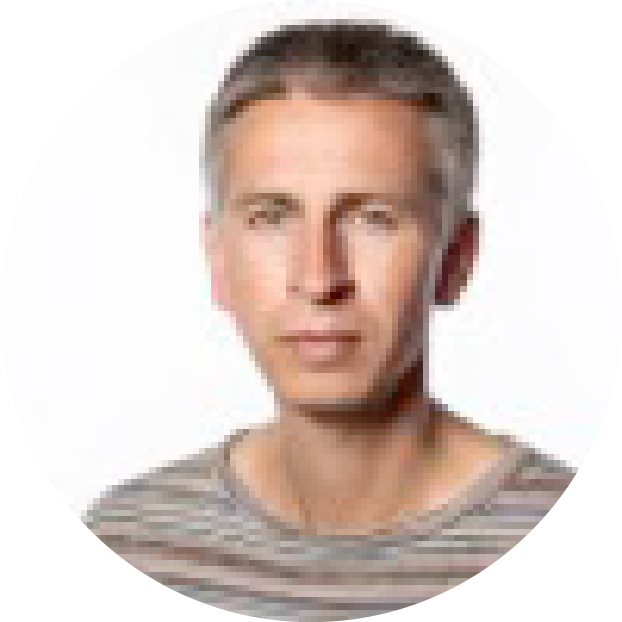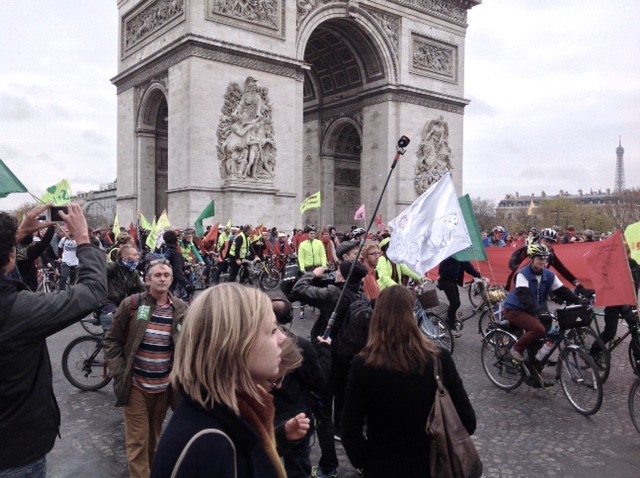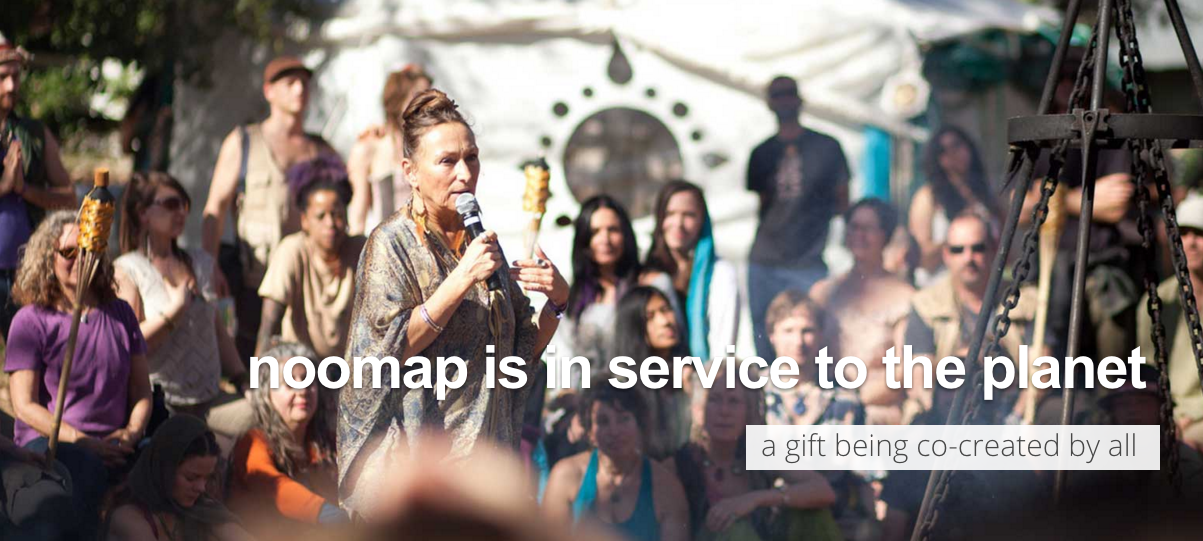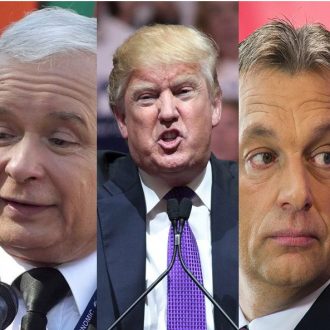
Thorsten Wiesmann is a Meditation Facilitator who has published books and several articles on the topic of social change and transforming the world.
“People alive today are tasked with transforming something
already built, failing, and destructive into something better. (…)
Anything can be used as a tool to transform the world.”
Wendy Jehanara Tremayne, The Good Life Lab.

In Paris, at 12:00 pm on 12/12. 2015 thousands of people took to the streets and created red lines along the major boulevard Avenue de la Grande Armée. This was a peaceful way to honor the victims of climate change and to show that the people’s voices are united in a call for bold climate action. — © Thorsten Wiesmann
The indispensable foundation of transformation towards global justice and unity comes from the power of grassroots social demand. Networks of “strong weak ties” make it possible for people to share resources and opportunities. According to the Weak Ties Theory the weak ties with our acquaintances are paradoxically much more important than the inwardly-focused conversations with our closer friends. Indeed, the information we discuss with our acquaintances often comes from wider sources.
In the familiarity of strong ties we use words where much is implicit and taken for granted. In communicating through the weak ties, we are asked to develop more explicitly elaborated ideas so that a meaning can be fully communicated. When elaborating, we have more scope for creativity and the thought that it stimulates makes innovation more likely.
The more weak ties we have, the more connected to the world we are and are more likely to receive important information about ideas, threats and opportunities in time to respond to them.
Societies and social systems that have more weak ties are more likely to be dynamic and innovative. If the system is mostly made up of strong ties, then it will be fragmented and uncoordinated.
Everyday Activism
Information sharing beyond social gatekeeping shows that we are at a critical juncture: on the one hand, there is this space that could enable a networked public to exchange views and design and articulate their own aspirations, and on the other, there are players who are unwilling to relinquish their role as powerful drivers of public opinion contesting this same space.
The challenge is whether the public is ready to push for greater participation or willing to settle for the same old relations to politics and mass media. Everyday activism is the habit of working socially conscious choices into our everyday lives. It could be described as “changing the world one habit at a time”. The sharing of personal stories in public spaces in pursuit of social change is one example of spreading ‘everyday activism’. This was the approach taken by French journalist, blogger and researcher Anne Sophie Novel who invited activists, speakers and representatives of various movements to collaborate on creating a new climate story at the alternative Climate Conference COP21 which met in Paris from November 28 to December 12, 2015. As friends and long time activists from Great Britain and Germany connected with Share International we had the great privilege of being invited together to this event, which was called Place to B, as well as several connected gatherings.
Place to B, which took place at an hotel near the Gard du Nord in Paris with 500 activists from more than 40 countries across the world included a program of workshops, briefings and talks by such esteemed people as Vandana Shiva, Vivienne Westwood, Naomi Klein, Amy Goodman, Nicolas Hulot and Charles Eisenstein.
We were particularly moved by what Charles Eisenstein said. He pointed out that we need to go deeper than just looking at how to reduce CO2, go deeper than the measurable and look at the underlying and overarching mythologies of who we are and how we relate to our planet. If we base our approach to climate change on seeking to maximize or minimize measurable quantities out of fear of negative results, it is exactly this faulty logic of economic growth. Applying this logic to address climate change is not a deep enough revolution and is ignoring the root causes. Eisenstein sums it up with the simple statement, ‘what we do to nature we do to ourselves.’
We can see that more and more voices from different backgrounds – like Richard Tarnas, Oliver Sacks and Satish Kumar – show us that now a new story of our common human interest is emerging, or perhaps we should say re-emerging. In this narrative, we are all members of one Earth community. Separation — the idea that living things exist individually, in isolation from each other — has been a dominant story for many centuries. Only by acting from a place of love and recognition of the sacredness and unity of life can we enter into the new story of the true interconnectedness of life — including the connections between science and art, physiology and psychology, the beauty and economy of the natural world and the magic of the human imagination.
As Camila Moreno, Daniel Speoch Chassé and Lili Fuhr write in Carbon Metrics: “It is important to keep in mind that the spread of the measuring mentality was an imperial project that could not tolerate other ways of doing things. The failure to recognize the different ways of knowing by which people across the globe run their lives and provide meaning to their existence is termed «cognitive injustice», or «epistemicide» (Boaventura de Souza Santos).”
Earth to Paris
Another event we were able to attend was called Earth to Paris, a gathering in the Petit Palais organized in cooperation with the United Nations to build a unique collaboration of 111 Movements joining forces to take bold action against climate change. The event took place on December 7/8, 2015 with more than 70 grassroots organizations from over 90 countries who came together to form a movement of movements about individuals to create action. This was done to provide an effective way for the world to raise its voice, showcase climate solutions and innovations, bring together communities to promote collaboration and to ask world leaders to advance a plan to combat climate change. 15-year-old Xiuhtezcatl Martinez, a youth activist from the Earth Guardians movement, summed up the intention of Earth to Paris as follows: “Climate change is the greatest chance humanity ever had, because we never had an issue before that had such a potential to unify humanity.”
We CARE Solar was one of the networks which presented solutions at this event, combining education and empowering local communities to give electricity to rural hospitals all over the planet. As part of the program, United Nations Secretary Ban Ki-Moon spoke with Yugarta Srivastava, now 19 years old, the youngest person ever to have the honour of addressing the United Nations, about her experiences regarding the things young people can do to counter global warming. Mr. Ban said: “Six years ago she appealed to me, saying, ‘ this is my world, please make it a better world,” and encouraged people to challenge their leaders and to raise their voices everywhere to make the world a better and proper place. He also reminded young people of their responsibility to contribute their part to the process of making the switch to safe energy, safe water, lower consumption, to end the use of plastics and to care for nature in general. Mr. Ban also mentioned in his remarks that while over a hundred leaders have attended these conferences before, the commitment has never been so great: “As Secretary General I have been attending many conferences and normally, maybe 150 leaders come, but they come on different days over a two-week period. Never on one day, at one time, in one place have 150 world leaders gathered.”
The climate generations area in the ‘green zone’ at the conference centre in Le Bourget, where the COP21 negotiations were taking place, welcomed the public to share in a broad range of presentations, discussions, environmental films and exhibitions. A couple of days spent there revealed an almost ubiquitous theme of the necessity of collaboration and unity for moving forward in a diversity of fields of endeavor.
Towards the Unification of the UNIFIERS
Finally, we also had the honour of being invited to the new United Earth headquarters in Rotterdam for the COM21 (Conference of the Movements) on December 10 and 11. This included an amazing presentation on Noomap by teammates Bret A Warshawsky and Chris Larcombe, a talk by Rajesh Makwana from Share The World Resources, a SKYPE conversation with Jon Ramer, a civic leader, inventor and musician who designed several online networks with sustainability, education, compassion or human rights as a focus, and other presentations on cutting edge thinking and technologies, to forge a global movement of movements.

Noomap is a revolutionary, game-changing technology in development that uses universal wisdom to empower and compute transactions in an environment in which people are free to explore other ways of ‘doing business’ and experiment with other kinds of exchanges and transactions, stimulating a sharing culture.
This gathering focused on spiritual, social and technological solutions for weaving together a ‘movement of movements’, not providing THE answer, but instead offering a beautiful seed crystal from which to grow a web of aligned and resonant heart-based relationships. Thanks to United Earth organizer Yan Golding from the Global Eco Village Movement and Robert Schram from the Meesteren Foundation, this was a first of its kind meeting towards manifesting an emerging open, inclusive, equality-based and solutions-oriented global platform for all people and groups dreaming and working for a better world, to unite and collaborate towards a whole-systems transformation of human society.
As Chief Phil Lane Jr., an internationally recognized indigenous leader in human and community development and founder of the Four Worlds International Institute, said at this gathering: “It is time now for a new kind of social synergy on Mother Earth as we move further into a global spiritual rebirth. Uniting the deep Indigenous wisdom of our elders with the genius of the new consciousness using more enlightened technologies, it is very clear we are poised for a wonderful global changing breakthrough!”
He came to Rotterdam from a six days gathering of Indigenous People from all over the world at Chateau Millemont, just outside Paris, where the French Revolution was secretly planned. The goal of this meeting was to prepare the final version of the paper “The Critical State Of Mother Earth” that integrates and distills the major scientific studies of the past four years on the deepening global environmental crises, including immediate unprecedented, unified action needed to address this crises.
The United Earth platform intends to promote and facilitate a broader and more effective collaboration among the many concerned dimensions of our global society. The ongoing goal is to invite change agents, grassroots leaders, organizations and movements from all over the world who are interested in co-creating a wave of intentional unification to move beyond words, into concrete and coordinated, unified and collaborative action.
To help catalyze the greatest unification in human history, United Earth and partners are seeking the UNIFIERS — people who recognize the imperative need and opportunity for humanity to come together to change the outworn system. United Earth is rallying people who are willing to rise above personal and organizational ideologies and methodologies, to pool and share their wealth of knowledge, solutions, innovations, alternative models, transition strategies, connections and resources, and to explore the monumental potential of our conscious collaboration.
As Henry Mintzberg writes in Rebalancing Society the ultimate social initiative has to address this question: how to consolidate the many social initiatives.
According to him we need for the spirit of balanced plural inclusion, based on open collaboration; responsible enterprise, concerned with the legitimate needs of all stakeholders; and engaging democracy, which seeks widespread involvement of the citizenry. No one of these can rebalance society, but together they can. Although the larger social movements, by facilitating communication, may raise consciousness about the need for renewal, it is usually smaller social initiatives, developed in collaborative community groups, that figure out how to do the actual renewing.
During our shared time in France and the Netherlands, we made new friends, learned a great deal, and took part in various artistic actions and several demonstrations. All of us have been spiritually and politically active for many years now, but never before have we experienced such a growing sense of unity and connectedness between such varying approaches, campaigns and concerns about our beautiful planet and all its inhabitants, human and otherwise. Together we sensed a fundamental shift in our relating and have a huge sense of optimism for our future.
Originally published at implizit.blogspot.de.
 Transforming the world during the Alternatiba meeting. Photo : Alternativa https://alternatiba.eu/paris/category/blog/
Transforming the world during the Alternatiba meeting. Photo : Alternativa https://alternatiba.eu/paris/category/blog/


